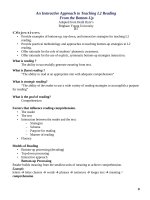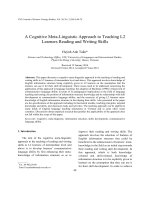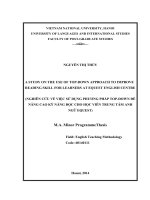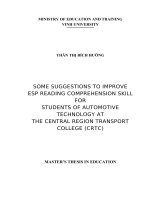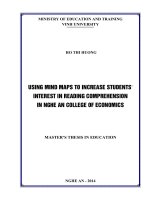Lexical instruction to improve l2 reading comprehension
Bạn đang xem bản rút gọn của tài liệu. Xem và tải ngay bản đầy đủ của tài liệu tại đây (1.06 MB, 53 trang )
Lexical instruction to
improve L2 reading
comprehension
Prepared by Nguyen Chi Duc,
School of English Language Teaching Methodology,
University of Languages and International Studies, VNUH
Foci
Section 1: Lexical load and
treatment
Understand the effects of lexical
load in a text on its
comprehensibility;
Section 2: Lexical tools in
unpacking a text
Use Vocabulary Size/Level Test to
learn about your students’ current
lexical sizes/levels;
Use repeated key words and its
referents to generate a text’s
general topic;
Use cohesive devices to draw
out the text organization;
Use Vocabprofile to analyze the
lexical load in a text;
Use the outcome from this analysis
to select what words to be treated
and taught;
Use the paraphrased patterns
to locate the needed
information in a text.
Use the four strands to select
suitable techniques for lexical
instruction.
1. A text’s comprehensibility
In groups of six, brainstorm all the factors
influencing your students’ reading comprehension
of a text, and then rank them in order of their
importance.
A brief summary of research
Background
Knowledge
Lexical base
Comprehension
Skills
Lexical Quality Hypothesis
(Perfetti and Hart, 2000)
Lexical
Decoding
knowledge
capacity
Text comprehension
Empirical findings:
Lexicon proves to be the most consistently influential factor on reading
comprehension
Chall (1958)
Klare (1963)
Elley (1969)
Carrel (1987)
Brown (1997)
A case study
Many students claimed that they could complete the required reading
tasks in the textbook, yet without a sufficient comprehension of the
target text.
Discuss the possible reasons for this claim in your groups.
2. Threshold of lexical load and a
text’s comprehensibility
Some key findings from research:
Density of 15% unknown words failed to understand (Marks et al.,
1974)
Density of 8% failed to understand (Freebody & Anderson, 1983)
Density of 7% able to understand (Holley, 1973)
Density of 5% reasonable understanding (Liu & Nation, 1985)
Density of 2% optimal to understand (Nation, 2001)
Suggested threshold of known
words in a text
95% - 98% known words
For
Reasonable Comprehension
(Nation and Webb, 2011)
3. Analysis of lexical load in a text
Discuss the following questions with your partners in your groups:
(a) How would you know what words your students may have learnt
or yet learnt before you actually start the lesson?
(b) How would you know how many words in a text might be
unknown to the target students?
(c) What so-called “new” words do you often choose to teach in the
pre-reading stage and why do you choose them?
1.
MAI NTAI N: Can they maintain it?
a. keep it as it is
b. make it larger
c. get a better one than it
d. get it
1.
SEE: They saw it.
a. cut
b. waited for
c. looked at
d. started
2.
TI ME: They have a lot of time.
a. money
b. food
c. hours
d. friends
2.
STONE: He sat on a stone.
a. hard thing
b. kind of chair
c. soft thing on the floor
d. part of a tree
3.
PERI OD: I t was a difficult period.
a. question
b. time
c. thing to do
d. book
3.
UPSET: I am upset.
a. tired
b. famous
c. rich
d. unhappy
4.
FI GURE: I s this the right figure?
a. answer
b. place
c. time
d. number
4.
DRAWER: The drawer was empty.
a. sliding box
b. place where cars are kept
c. cupboard to keep things cold
d. animal house
5.
POOR: We are poor.
a. have no money
b. feel happy
c. are very interested
d. do not like to work hard
5.
PATI ENCE: He has no patience.
a. will not wait happily
b. has no free time
c. has no faith
d. does not know what is fair
6.
DRI VE: He drives fast.
a. swims
b. learns
c. throws balls
d. uses a car
6.
NI L: His mark for that question was nil.
a. very bad
b. nothing
c. very good
d. in the middle
7.
J UMP: She tried to jump.
a. lie on top of the water
b. get off the ground suddenly
c. stop the car at the edge of the road
d. move very fast
7.
PUB: They went to the pub.
a. place where people drink and talk
b. place that looks after money
c. large building with many shops
d. building for swimming
8.
SHOE: Where is your shoe?
a. the person who looks after you
b. the thing you keep your money in
c. the thing you use for writing
d. the thing you wear on your foot
8.
CI RCLE: Make a circle.
a. rough picture
b. space with nothing in it
c. round shape
d. large hole
9.
STANDARD: Her standards are very
high.
a. the bits at the back under her shoes
b. the marks she gets in school
c. the money she asks for
d. the levels she reaches in everything
9.
MI CROPONE: Please use the microphone.
a. machine for making food hot
b. machine that makes sounds louder
c. machine that makes things look bigger
d. small telephone that can be carried around
10.
PRO: He's a pro.
Question 1: Understand your students
/>
Question 1: Understand your
students
Vocabulary sizes test
Vocabulary levels test
(Nation, 1990)
(Beglar & Nation,
Scoring: correct
2007)
> 83% = 100% at each
answers x 100
level
Interpretation: 3000 = > 83% in K2, K3, K5, AWL
K3 this learner
this learner might know
might know 3000
roughly 7000 most
most frequent word
frequent word families in
families in English.
English.
Question 2 + 3: Lexical load in a
text
/>
Question 2 + 3: Lexical load in a
text
The rest are proper nouns which are then not counted in this
profile.
Question 2 + 3: Lexical load in a
text
4. Treatment of the overloaded
vocabulary items
Discuss in your groups the following questions:
(a) how do you often present a new word’s meaning to your learners?
(b) how do you often help them to practice it?
(c) are these techniques effective for their uptake, retention, and use
of the target words’ form and meaning?
Four strands in vocabulary teaching
(Nation, 2007)
Meaning-focused
Learners have chance to meet a new
input
language pattern in a meaningful context.
Meaning-focused
They have chance to trial this new language
output
pattern in a meaningful way.
Language-focused
They also have chance to intentionally learn it.
learning
Fluency development
Finally, they have chance to automatize its use in
communication.
Four strands in vocabulary teaching
Suggest one teaching activity for each strand above:
Meaning-focused
input
Meaning-focused
output
Language-focused
learning
Fluency development
Four strands in vocabulary teaching
Four strands (Nation,
Suggested techniques (Nation &
2007)
Webb, 2011)
Meaning-focused
L2 lexical inferencing
input
Meaning-focused
Meaning negotiation
output
Language-focused
Word cards
learning
Fluency development
Prompted speaking
5. Treatment of overloaded vocabulary
items – L2 lexical inferencing (Haastrup,
1991; Nguyen, 2012)
Core Principle:
Try to create a favorable condition for your students to make good
guesses (Nation, 2001) since good guesses would benefit their uptake,
retention and use of the target words, and poor guesses can be
dangerous due to its traits being imprinted on your students’ brain.
Discuss, in your groups, how to create such a favorable condition.
L2 lexical inferencing
Supportive contextual clues;
98% of the words in the context known to your
students;
Strategy training.
Some common contextual clues
Practice:
(1) use vocabprofile to ensure the threshold of 98%
known words in the context, (2) modify the context to reach the
threshold if necessary, and then (3) embed some contextual clue for
each item.
Treatment of overloaded vocabulary
items – negotiation of meaning
Read
the extract from a study by Nation and
Hamilton-Jenkins (2000) and discuss the
benefits of this activity.
Practice:
(1) guess the meaning of the underlined words, and
then (2) negotiate their meanings with your friends in your groups.
